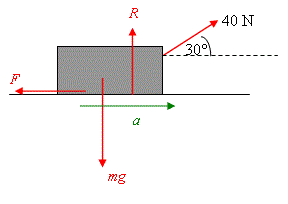Solution 10.7
From Mechanics
We have drawn all the forces acting on the block in the figure. The acceleration is represented by the vector \displaystyle a.
Applying Newton´s Second Law \displaystyle F=ma horisontally,
\displaystyle \begin{align} & \to :\ 40\cos {{30}^{\circ }}-F=ma \\ \end{align} ration is represented by the vector \displaystyle a.
We need to obtain \displaystyle F.
Note that \displaystyle R is NOT equal to \displaystyle mg here as the string has a component force in the vertical direction! In fact one has,
\displaystyle \begin{align} & \uparrow :\ R+40\sin {{30}^{\circ }}-mg=0 \\ & \\ & F=mg-40\sin {{30}^{\circ }}=3\times 9\textrm{.}81-40\times \frac{1}{2}=29\textrm{.}43-20=9\textrm{.}43\ \text{N} \\ \end{align}
Using the friction equation gives
\displaystyle \begin{align} & F=\mu R \\ & \\ & F =0\textrm{.}5 \times 9\textrm{.}43 = 4\textrm{.}71 \ \text{N} \\ \end{align}
Substituting in the above equation of motion (Newton´s Second Law) gives,
\displaystyle \begin{align} & 3a=40\times 0\textrm{.}866-4\textrm{.}71=29\textrm{.}93 \\ & \\ & a=9\textrm{.}98\ \text{m}{{\text{s}}^{-2}} \\ \end{align}

